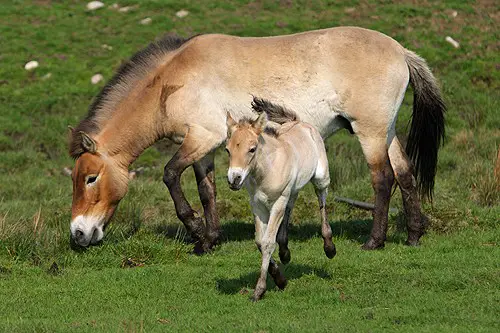The przewalski's horse (Equus ferus przewalskii) is a species of horse found in Asia. It is considered as 'critically endangered' by the IUCN. It is also known as the Dungarian horse and has recently been introduced to the wild.
Physical Features
The przewalski's horse closely resembles a domesticated horse. Its fur is a dull grayish brown in color. The przewalski's horse stands about 4.3 feet tall (52 inches) and measures 2.1 meters in length (6.11 feet). Its fur has some pangaré features.They have a dark brown color around the mane on the neck and a pale brown color on the flanks and a yellowish white color on the belly and around the muzzle. They have shorter legs than feral horses and have faint stripes on their body. These horses can weigh more than 310 kilograms.
The przewalski's horse is mainly herbivorous, eating grass. Some of these horses rest in salt licks to obtain enough minerals. Przewalski's horses need a lot of nutrients everyday as they travel more than six miles per day with their group.
 |
| A female horse with its offspring. |
The behavior of a przewalski's horse resembles the behavior of a domesticated horse. They live in groups which consists of a stallion, who leads the group and mares with their offsprings. The przewalski's horse is diurnal; they are active only during the day. At night, they all sleep together for about four hours.
Distribution and Habitat
The przewalski's horse is foound in the steppes of Mongolia and China, Asia. They were once extinct in the wild but were re-introduced.
Conservation Status
The przewalski's horse was extinct in the wild but were introduced to Khustain Nuruu National Park, Takhin Tal Nature Reserve and Khomiin Tal, which contains their natural habitat. These national parks are in Mongolia. In 2005, the population of these horses were 1500 which include individuals in wild and in captivity but the population has increased since then. They are rated as 'critically endangered' by the IUCN.

No comments:
Post a Comment